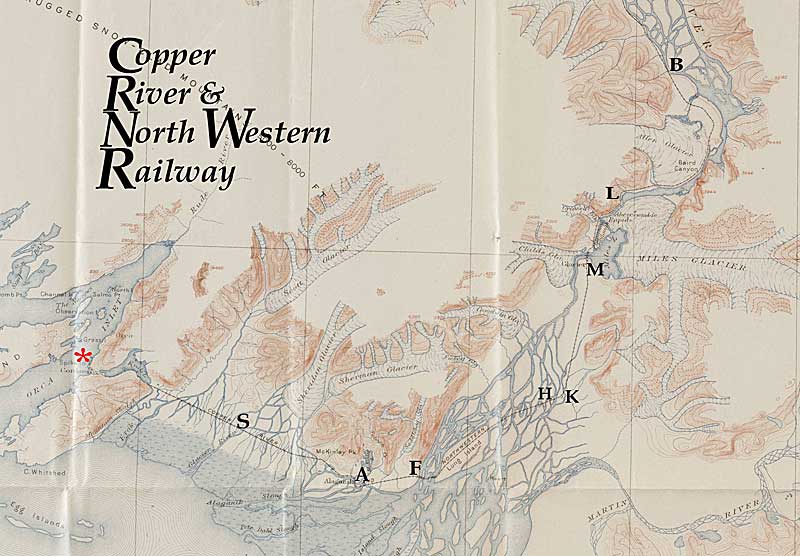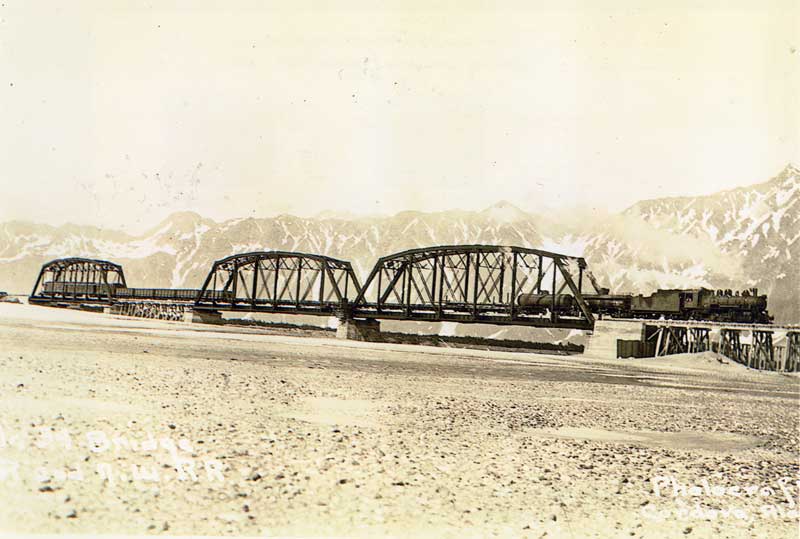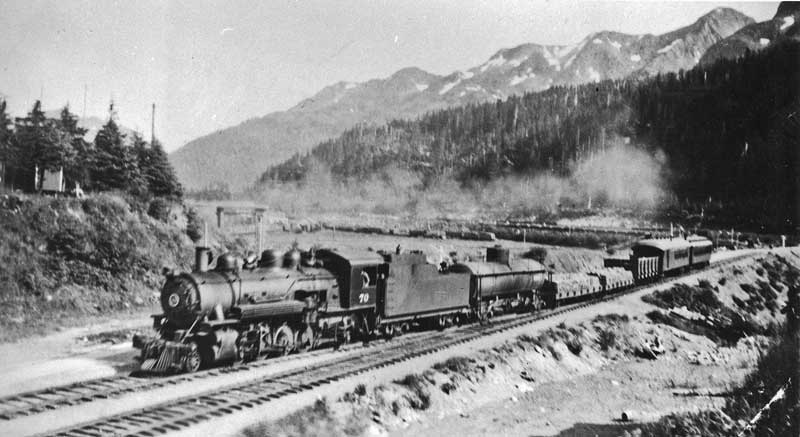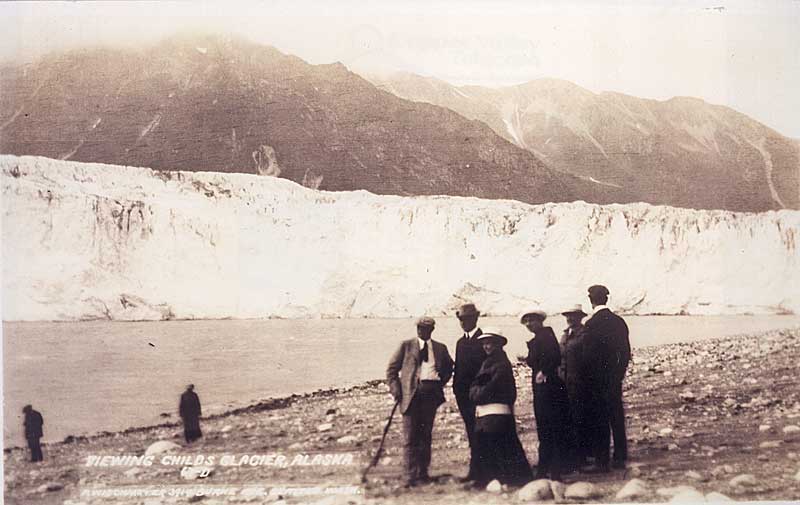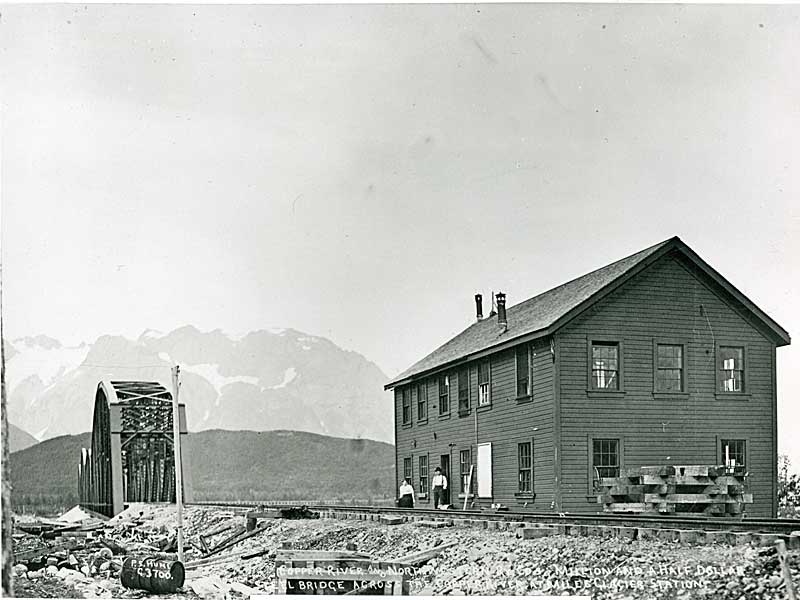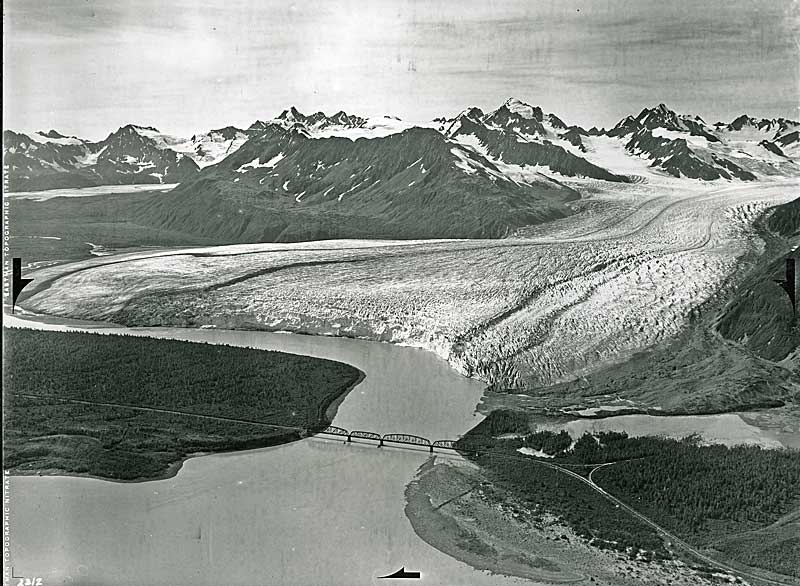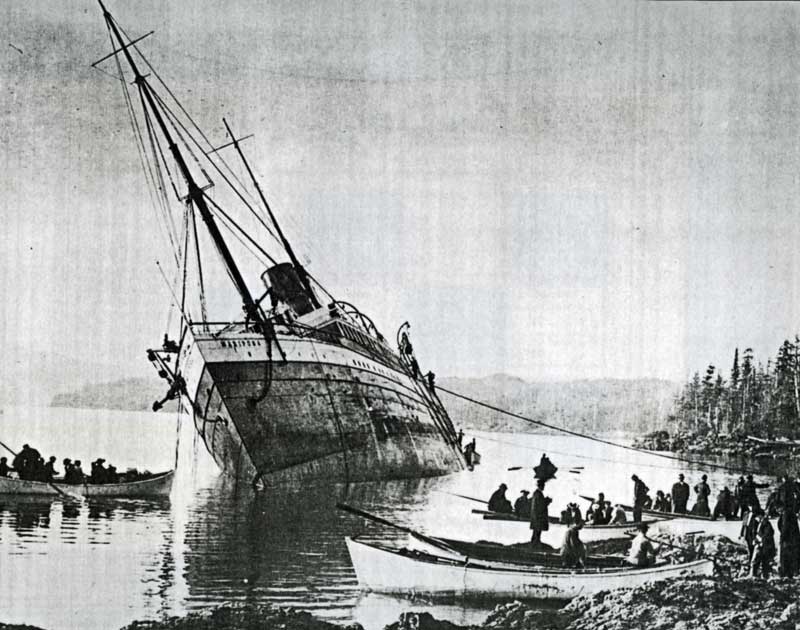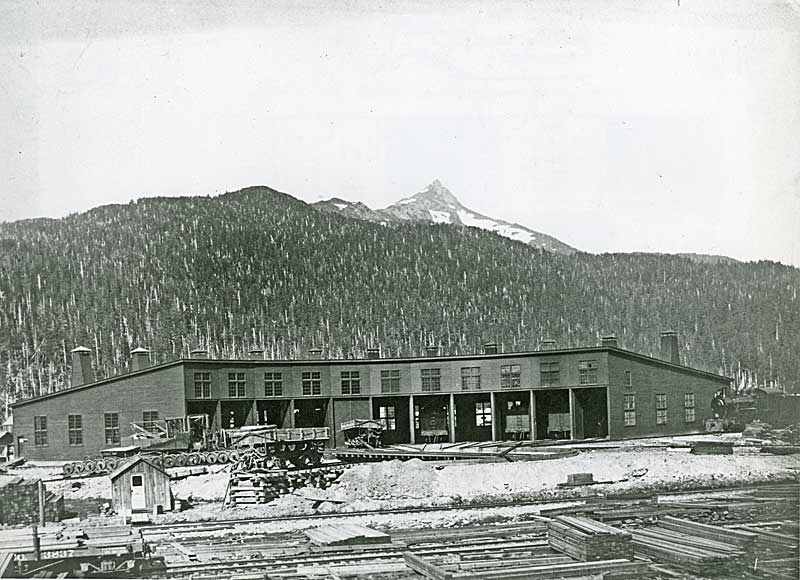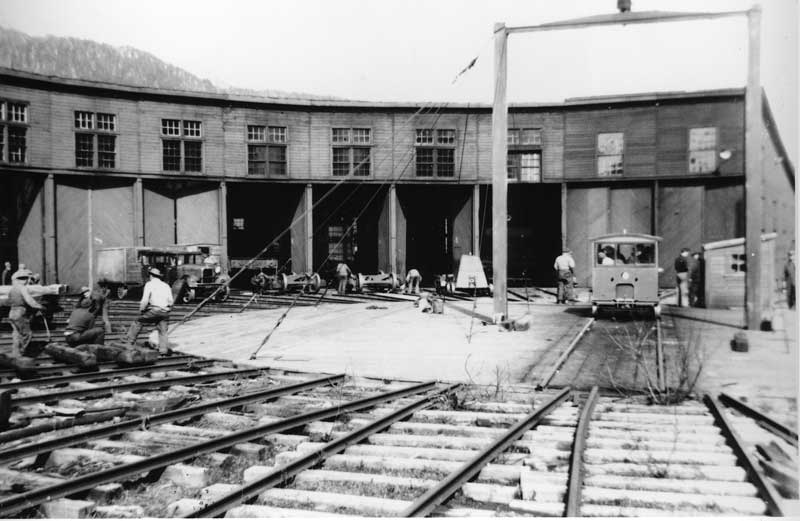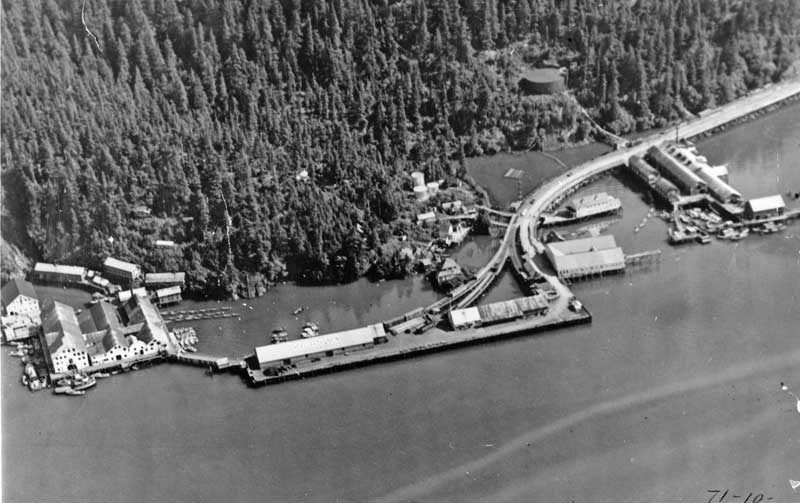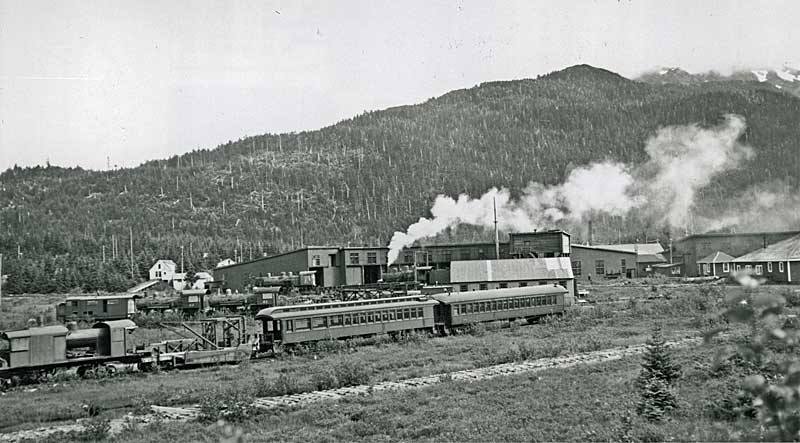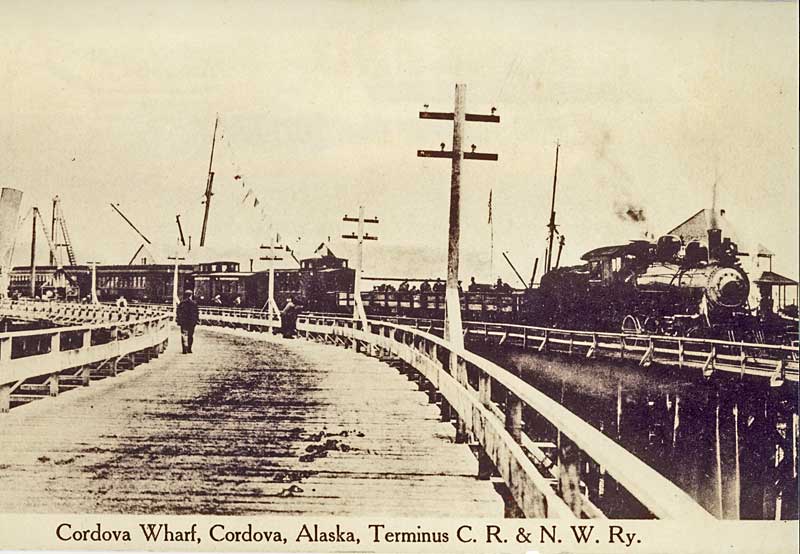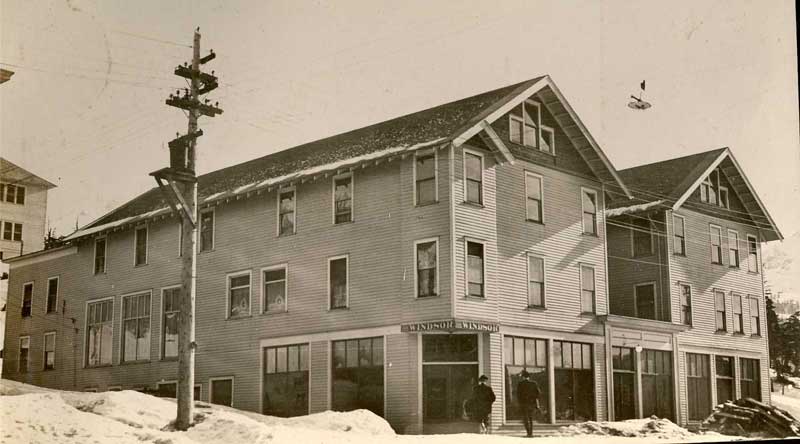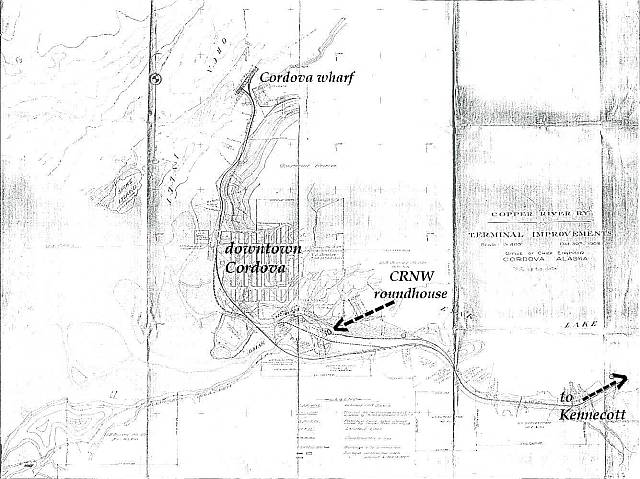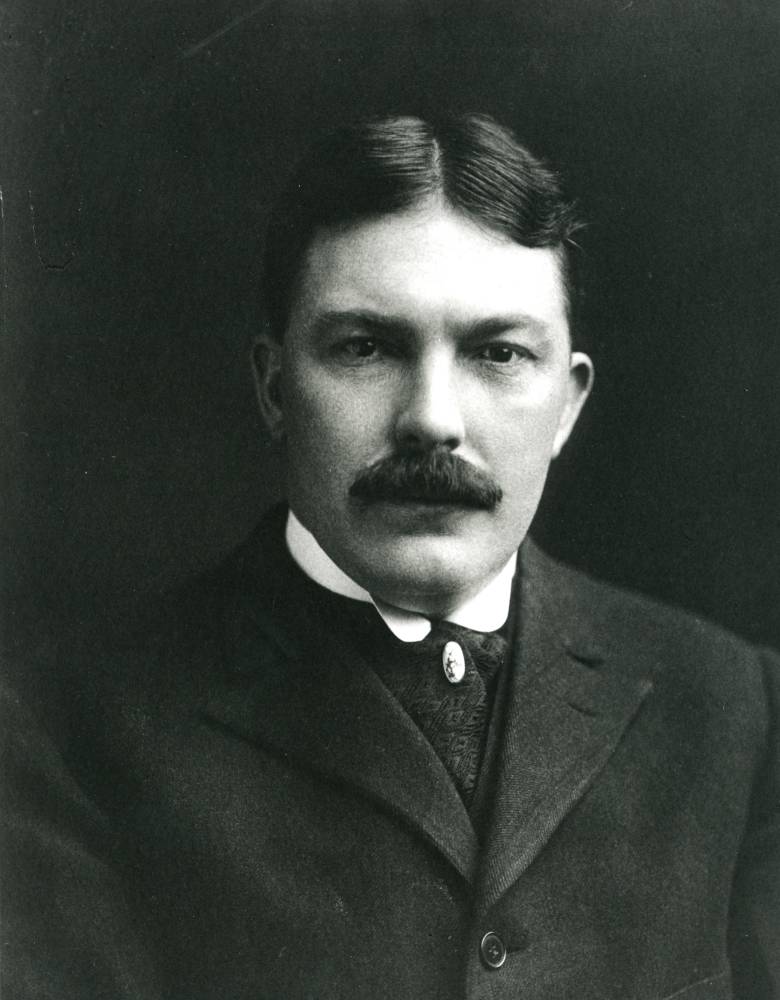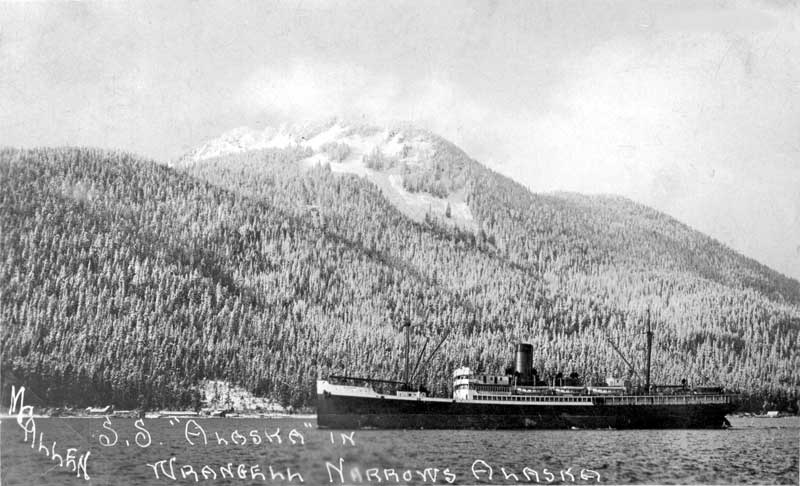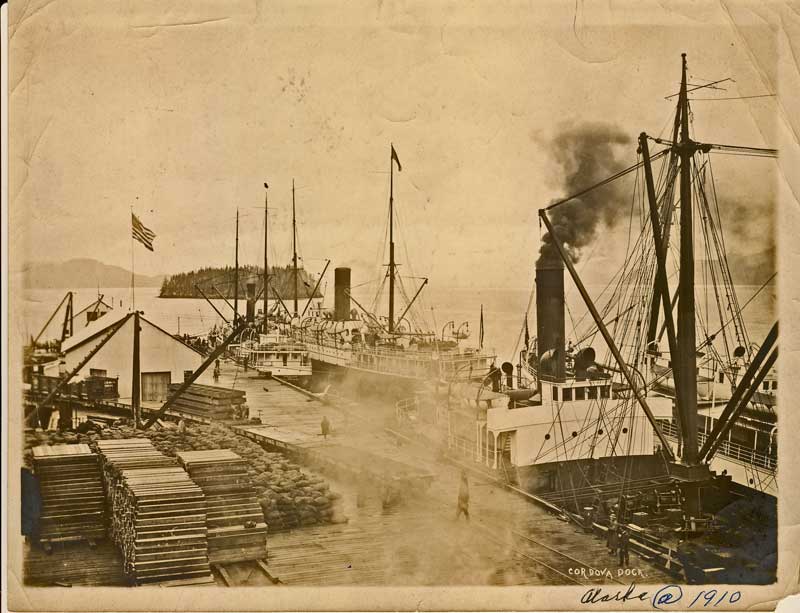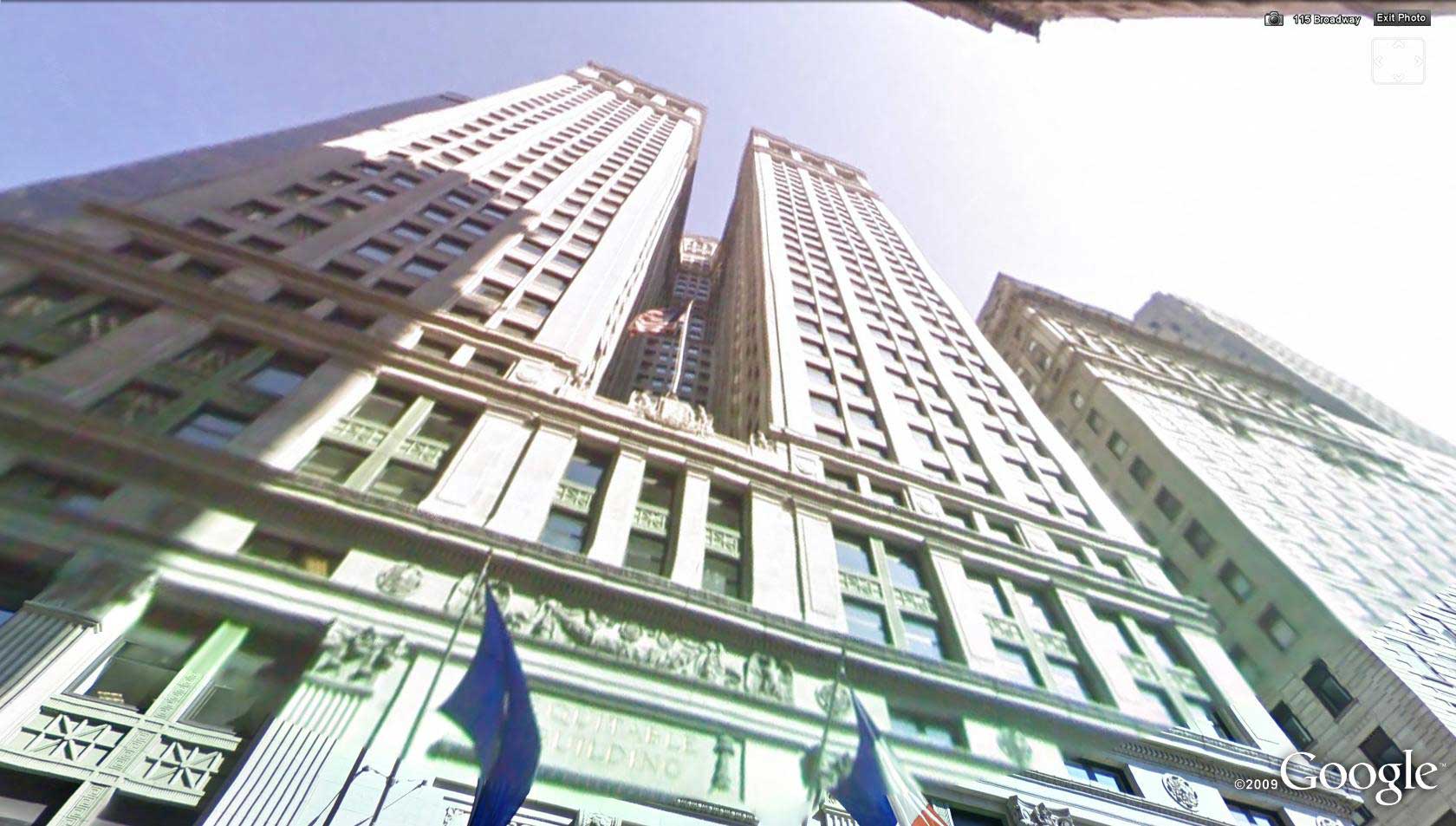Chapters from the historic novel "Legacy of the Chief," by Ronald Simpson, and other items mostly related to the historic background of the Ahtnas in the context of Kennecott Copper & its Copper River & Northwestern Railway.
05 November 2010
Ch 12, Pt 2: "Mary & Stephen Birch Arrive at Childs Glacier
Chapter 12: Mary and Stephen Birch Arrive at Childs Glacier | ||||||||
click on picture for larger image: these pictures are the one which appear in the book for this chapter. | ||||||||
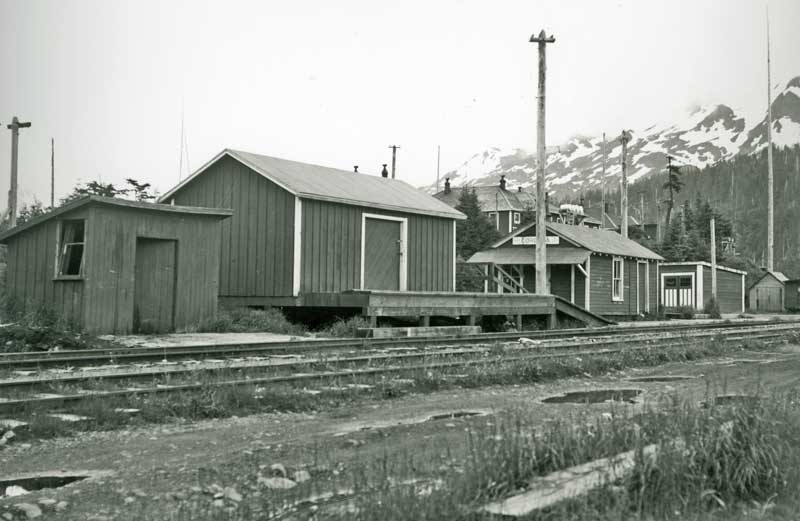 | ||||||||
Cordova depot area after RR abandonment --Cordova Museum | ||||||||
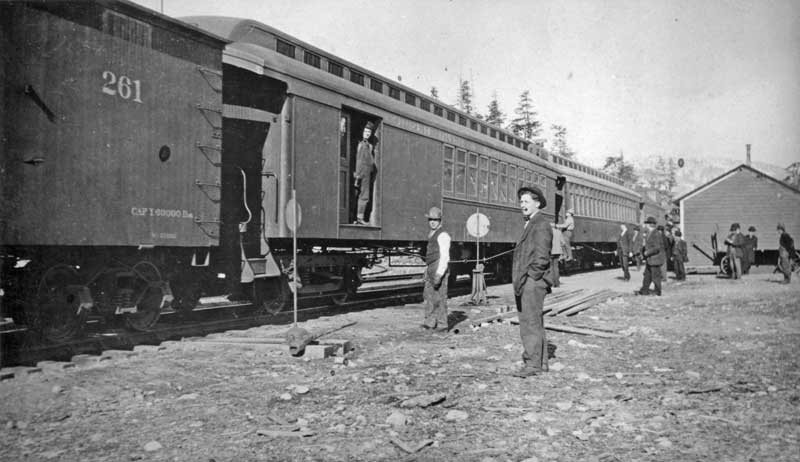 | ||||||||
Below: A Miles & Childs Glacier excursion train leaves Cordova --Cordova Museum | ||||||||
 | ||||||||
Below: Cordova RR yard with the town site in distance: --Laurie Nyman collection | ||||||||
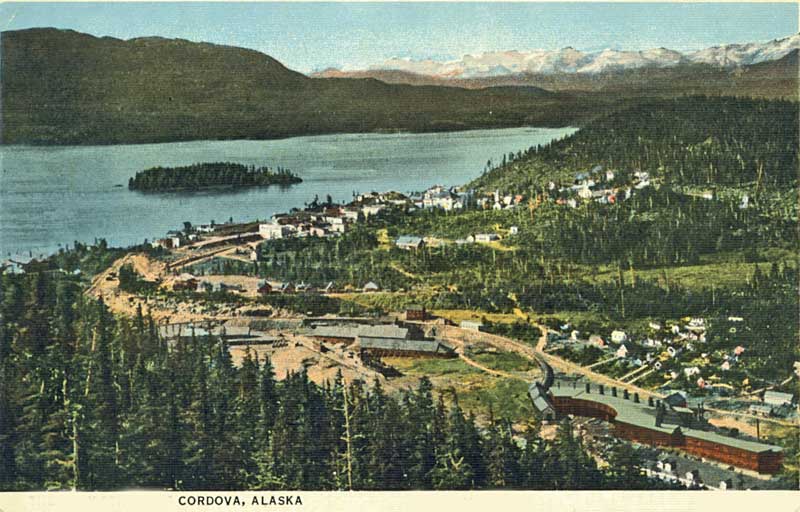 | ||||||||
The train left Cordova in an easterly direction, following a relatively flat glacial out-wash for the first twenty miles, crossing many small streams before it reached the foothills south of Sheridan Glacier. It followed along the hills until reaching the first crossing of the Copper River at Flag Point, CRNW mile 27. This was a complex bridge set-up, consisting of a series of wooden trestle approaches connecting nine narrow steel spans. The longest of these spans was 300 feet. This is the area of heavy winter winds that approached 100 miles per hour, causing snow drifts high enough to completely bury entire trains, as had happened in the past. The five days in Cordova were mostly sunny, as was this day. The ten mile-wide delta with its countless ducks and other birds seemed to extend almost forever in the glimmering rays which reflected back off the long expanses of partly-submerged lowlands covered with thick marsh weeds.
Once it crossed the bridges at CRNW mile 27, the train began heading north. It was far enough away from the shore to enable a good view of the southern edge of the Chugach Range. Then the train passed the steel bridges at Round Island, CRNW mile 34. These crossings consisted of a 200 foot span extending to a sand bar, then a wooden trestle which bridged the bar that extended to two more 200-foot steel spans. Now it was only a few miles to the Million Dollar Bridge.
Continue with "Mary and Stephen Birch Arrive at Childs Glacier" |
Ch 12, Pt 1: "Mary & Stephen Birch Arrive at Childs Glacier
Chapter 12, Pt 1: "Mary and Stephen Birch Arrive at Childs Glacier" | ||||||||
click on picture for larger image: these pictures are the one which appear in the book for this chapter. | ||||||||
Locomotive no. 74 was the fifth and last of the series of great engines of the Mikado class type purchased to upgrade Stephen’s ore train fleet. The CRNW had no 100-ton crane at the wharf, which was the minimum capacity needed to off-load the 95-ton locomotive. Tidal fluctuations at Cordova allowed an alternative means to deal with so large a piece of rolling stock cargo. The ship was kept in position until the tide lowered the reinforced deck to the same level as the dock. While the ocean level at the dock dropped the necessary twenty-two feet, the men installed rails from the engine to the edge of the ship on top of heavy planking. The engine was already sitting on rails bolted to planking. It had been loaded into place at Seattle using a large crane, which made the setting of the engine into place an unusually difficult feat. Yet there it sat, still heavily tied into place, still sitting comfortably on those seventy-five pound rails just as it had when it was so carefully dropped into place. The men ran temporary rails to the point on the dock where they would meet with the ship, running past the dock’s edge eight feet so that there would be no joint between the ship and the dock. The railroad workers joined the temporary rails at the critical moment when the tide level was perfect for the transfer. CRNW engines #70 thru 74 were the same series and were used primarily as ore-haulers By then, the tie-downs were removed and the engineer had the locomotive steamed up and ready to move. He stayed with the engine to ensure that the steam pressure and water levels remained just right for moving the massive locomotive under its own power. When the moment came, the men performed a final alignment of the rails and bolted them together. The foreman signaled the engineer and Dusty pull the reverse handle, allowing the engine to creep forward. The engine had been loaded so that it would point toward the dock, given the most likely way the ship would approach the wharf. The extremely heavy, self-powered load departed the ship with considerable creaking through the rails, the ship and the dock. The stevedores ensured that the ship could not dip because they had temporarily secured it tightly against the dock. It was imperative that the engine not tip at all. It left the ship smoothly. Stephen Birch and his party watched the entire procedure. He had asked the company to alert him when the tide was in the right position. His party arrived in a horse-drawn carriage owned by the hotel. The engine rolled onto the dock without a hitch to a loud round of applause. The loud whistle reverberated as the engine moved off to the eleven-bay roundhouse for a final check. Mogul No. 102 was the back-up assigned to Stephen’s private train. At eighty tons, it was considerably smaller than the Mikado which had just arrived. With its six large drive wheels, the engine could pull a small consist in excess of sixty miles per hour over most of the line. The mogul was ideal for Stephen’s private train, but it would not be used. Stephen wanted to use the newest and proudest, if an inanimate object could be described that way, of the great CRNW engines. He left no doubt to Superintendent Hansen that he wanted his private train headed by the mammoth No. 74. So it would be.
On the day the engine was ready, Stephen was at the turntable to watch No. 74 pull out of the bay onto the turntable. A worker started the powerful electric motor which swung the huge engine around until it was lined up with the exit rail. No. 74 blasted its whistle and rumbled off the wooden turntable deck. The crew linked a combination baggage and passenger car behind the tender and then added “The Kennecott” to the rear. All was ready for the train trip into the great interior over the “Route of the Marvelous Scenic Wonders.” In 1916 the CRNW was still the only standard gauge railroad entering interior Alaska, though the new Alaska Railroad would soon be operating a much larger line out of Seward to Ship Creek and beyond. The first passenger cars would travel the line from Seward to the new town of Anchorage in October. The government-built railroad would ultimately reach Fairbanks in mid-July, 1923--seven years after the Birch honeymoon trip. The choice of the government to build the railroad out of Seward instead of purchasing the existing CRNW and using the Cordova terminal guaranteed the end of the CRNW when the mining engineers declared Kennecott’s interior copper mines to be exhausted in 1938. Yet in the summer of 1916 it appeared that the CRNW was a permanent railroad which would last almost forever. In the few years since the railroad first opened its line to the Bonanza Mine the CRNW had filled in many of the long trestles which crossed the expansive Copper River delta with tens of thousands of cubic yards of gravel fill. Permanent steel bridges existed at CRNW mile 27, 34, 49 and 144. The railroad met high engineering standards and was considered a first-class system at least as far as CRNW mile 131, which was the Chitina depot. The consist left Cordova after five days instead of the two which Stephen had planned because Mary claimed to be too ill to travel. By the time Mary decided she was ready to travel, she was becoming quite unpopular with the rest of the party.
|
04 November 2010
Ch 11, Pt 2: "Mary Storms into Alaska"
Ch 11, Pt 1: "Mary Storms into Alaska"
Chapter 11: "Mary Storms into Alaska", pt 1 | |||||||||||||||||||||
click on picture for larger image: these pictures include the ones which appear in the book for this chapter. | |||||||||||||||||||||
sick. The trip to Seattle had been pleasant enough. The S.S. Mariposa made it all the way to Juneau on relatively calm seas. It rocked gently but not violently. Then the Alaska Steamship passenger liner entered the open waters of the Gulf of Alaska. The seas become so turbulent that Mary could hear the whirring sound of single propeller as it momentarily left the water before the see-sawing of the ship pulled the bow high into the air, submerging the stern. The ship also began rocking sideways much more than she would ever have imagined possible.
What began as an exciting honeymoon excursion culminating in a trip on the Alaska Steamship vessel and a train ride into the Copper River valley was looking increasing like just another one of Stephen’s business trips. He had taken it upon himself to make all the arrangements without consulting her. At the time, it all seemed acceptable to Mary. She was used to her father making all the important decisions in her life. It was he who had first introduced her to Stephen. She first met the man at an extravagant ball in New York City on an excursion paid for by her father Rufus. Mary was completely taken in by his quiet charm. She wanted a sophisticated, but well-heeled gentleman. It would be even more ideal if the suitor was from New York City or Boston or some other city of culture. After all, she was a debutante of high social upbringing. Her father, Rufus Rand, headed Minneapolis Gas Light Company, which placed her high in the elite social circles. She wanted a man of considerable physical attraction who had the right background and stature. That wasn’t too much to ask. Stephen had no blue-blood. He was not a Rothschild or an Astor. Although Birch’s best man was a Havemeyer and one of his ushers was a Rockefeller, Stephen’s parents were of humble origins. But relative unknown though he was, he nevertheless headed that large copper company and therefore he had power. With the power came wealth and status. He was tall and attractive. He was from the wrong family, but two out of three would have to do.
Stephen only recently made his name by virtues of his wild successes in the copper mining business of Alaska. His fortune originated from some very far distant and ice-encrusted place suitable only for the very hardy or foolish. Or, worse yet, the very crude. Mary was not crude. She was refined and sophisticated. She went to great lengths to let everyone know that.
They left New York City in a specially outfitted Pullman private car built to Stephen’s specifications. The car was comfortable but not ornate by east coast standards. Stephen liked some of the trappings of power, but he shied away from the ostentatious. On the contrary, he showed all the modesty and humility which one would expect from a man born of common people, much to Mary’s distress. Someone in the company named the Pullman coach The Stephen Birch, but Birch re-named the observation car The Kennecott. Birch was a background player. He did not like to see his name stand out in public. Mary wanted all the status she could gain through her new husband’s position. She did not learn until later that the Kennecott had briefly existed as The Stephen Birch. She was not pleased to learn of the change of the name, which she through Dermot, one of her husband’s aides. The change of name robbed her of a small measure of status which was, after all, her entitlement as wife of the president of Kennecott. At least the ride through Great Northern Railroad country had been spectacular. All the accompanying wedding guests were stunned by the sights along the mountainous part of the route. Mary was more concerned with what opera would be playing at the theater in Seattle when they reached that west coast port city. Seattle has been known as a center of cultural activity since well before the turn of the century. Mary was at best mildly impressed. No opera was playing when they arrived. Mary found the Broadway theater production to be vulgar. On the other hand, she found that the Olympic Hotel was up to the level of catering and luxurious appointments she required. The entire wedding party remained in Seattle several days while Alaska Steamship completed the outfitting of the S.S. Mariposa for this elite wedding party. The steamship company knocked down walls to convert five rooms into one elegant stateroom for the new high-society couple. At the same time, arrangements for hauling the last of the great Mikado Brooks engines were being completed. This required considerable re-decking for the heavy, Cordova-bound load.
The trip north through the Queen Charlotte Islands and Southeast Alaska had been stunning. As is typical in this part of the Northwest, the mid-summer seas were calm. Mary failed to appreciate the sunshine which followed the honey-mooners as far as Juneau. Such good weather over the West Coast for three days in a row is rare in this part of the world at any time. The clear skies revealed a delightful area of prime old forest land of intense rugged beauty. Even Mary was impressed. She found viewing such forested fjords in the Alexander Archipelago from the luxurious comfort of an Alaska Steamship liner to be thrilling. A unique sense of luxury she never before experienced came with the passage through the panhandle of Alaska while the snappy waiters did their best to cater to her every demand. She had many demands. Yet Mary’s relative good mood did not extend to the help who had to serve her. The staff learned to dislike Mary intensely. She proved to be excessively difficult to please while being only too quick to criticize. Everyone from the captain on down was only too well aware that Stephen Birch controlled the company which owned Alaska Steamship. The staff was accustomed to serving middle-class people. This voyage was more like entertaining royalty. The staff was barely up to the job of continually anticipating and carrying out Mary’s many demands.
The cruise was not a charter, despite the considerable work done to accommodate the wedding party. Other paying passengers were aboard. The ship had a scheduled stop in Juneau. Stephen and the party of upper-class men and company officials wanted to visit the Treadwell Mine across the channel and the new Alaska-Juneau Mine This was of no possible interest to Mary. She was left to her own devices at the Baranof Hotel, where she was free to terrorize the hotel staff while Birch and his mining cronies visited those enormous gold producing operations. Stephen was beginning to appear to be more interested in business than he was in their marriage. Mary’s predisposition against Alaska was only strengthened by Stephen’s side trips to those mines. When the ship left the archipelago and entered the Gulf of Alaska it encountered a storm which mercilessly pounded the vessel. The 95-ton locomotive on the reinforced front deck caused the ship to be excessively top-heavy. It began to toss and roll dangerously. Mary was sick and felt compelled to leave her stateroom for the outside rails. She was not the only one, but no one else’s problems mattered to Mary. Finally the Mariposa steamed itself out of the storm and quietly slipped into the Cordova harbor, but Mary’s insides told her the ship was rocking. It would be days before she felt well enough to continue.
“The trip was ghastly, Stephen. I thought I’d die out there. It looked like the whole ship would come apart or tip over.” “We were really worried about losing No. 74. We were afraid it’d break loose.” “Number 74? Stephen, I, your brand-new wife nearly dies on our honeymoon voyage and all you’re concerned about is an engine? All you care about are your machines and your mines. Why’d I ever marry you? Some husband.” “Mary, calm down. I know you didn’t mean that. I’m sorry about that storm and how sick and scared you must have been.” “I was frightened to death, Stephen. If I want that kind of experience, tie me down to the big roller coaster at Coney Island. And sick, I’ll be sick for days.” “Maybe coming to Alaska for the honeymoon wasn’t the best idea I ever had.” “Stephen, I don’t know why I ever let you talk me into this trip. You know how little I care for wilderness or mining--especially in this ice-bound Alaskan wilderness of yours. I don’t feel like traveling in anything now that I’m off that cursed ship of yours. That horrible, heavy engine you had to bring along caused that ship to sway wildly all over the place. I don’t care if I ever ride another train again.” “Darling, Mary, what am I going to do with you? We’re here. We’ve arrived in Cordova. I’m sorry that the storm was so violent. Didn’t feel so well myself. Most of us got sick from it, but we still have that train trip ahead of us. You’ll love it. It’s far better than the much longer Great Northern run we just took.” “I don’t want to go, Stephen. If you must go, then go without me.” “Darling, Earl Stannard built us a special honeymoon cottage at Kennecott. We have to go. It wouldn’t be right not to go now. You have to come along. You can do it, Mary, you’ll be all right.” “Stephen, I’m not going.” “Mary, you are my wife, and you are going and that’s that. It’s time you grew up. You are the wife of a man who heads an important American corporation. Now act your part. You know I do everything I possibly can to see to your every need and desire. Besides, Alaska is not ice-bound. It’s not even that rugged anymore, either. Not like it used to be. We built a modern railroad and transformed the Copper valley region into an extension of our world-wide copper empire.” From 1915 until the 1950s, the Kennecott corporate offices were here in the Equitable Insurance Building, NYC
|
Subscribe to:
Posts (Atom)
